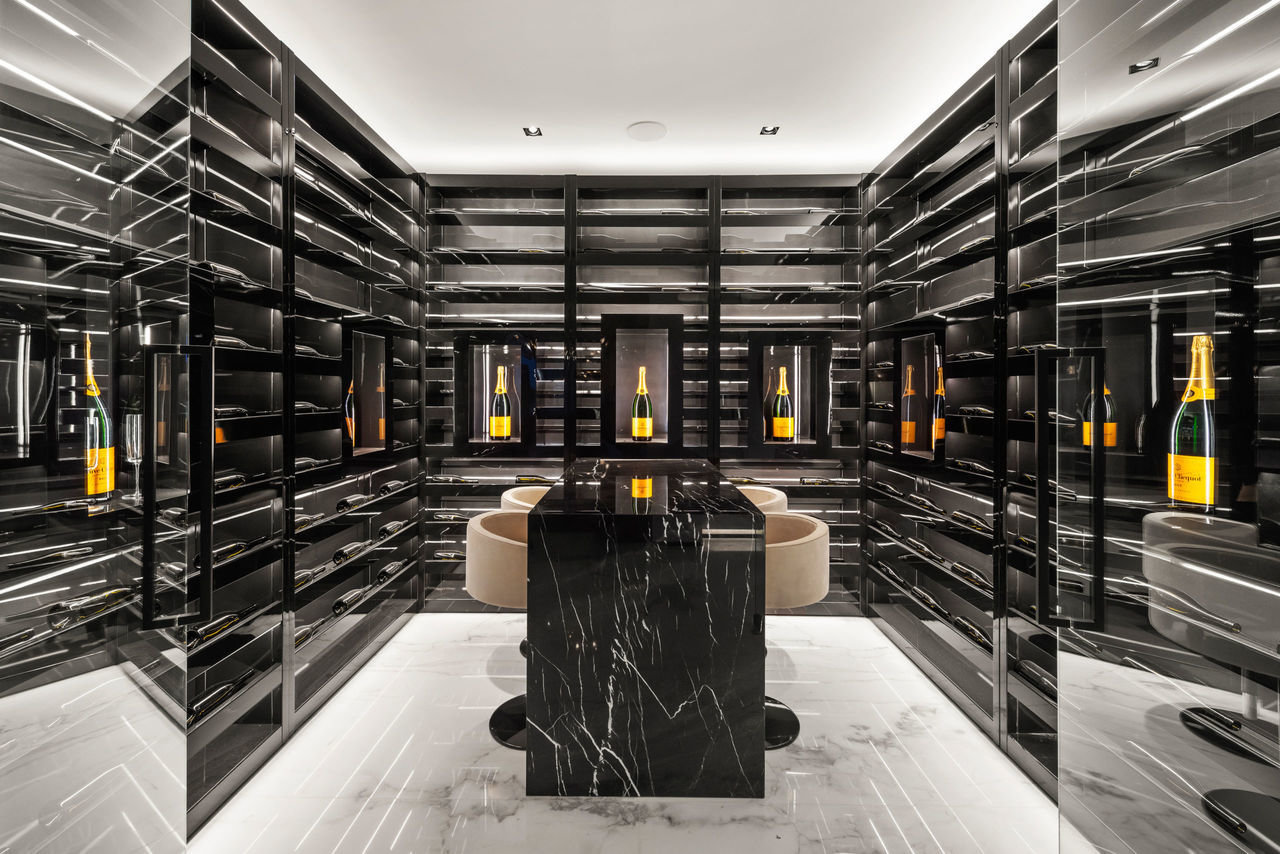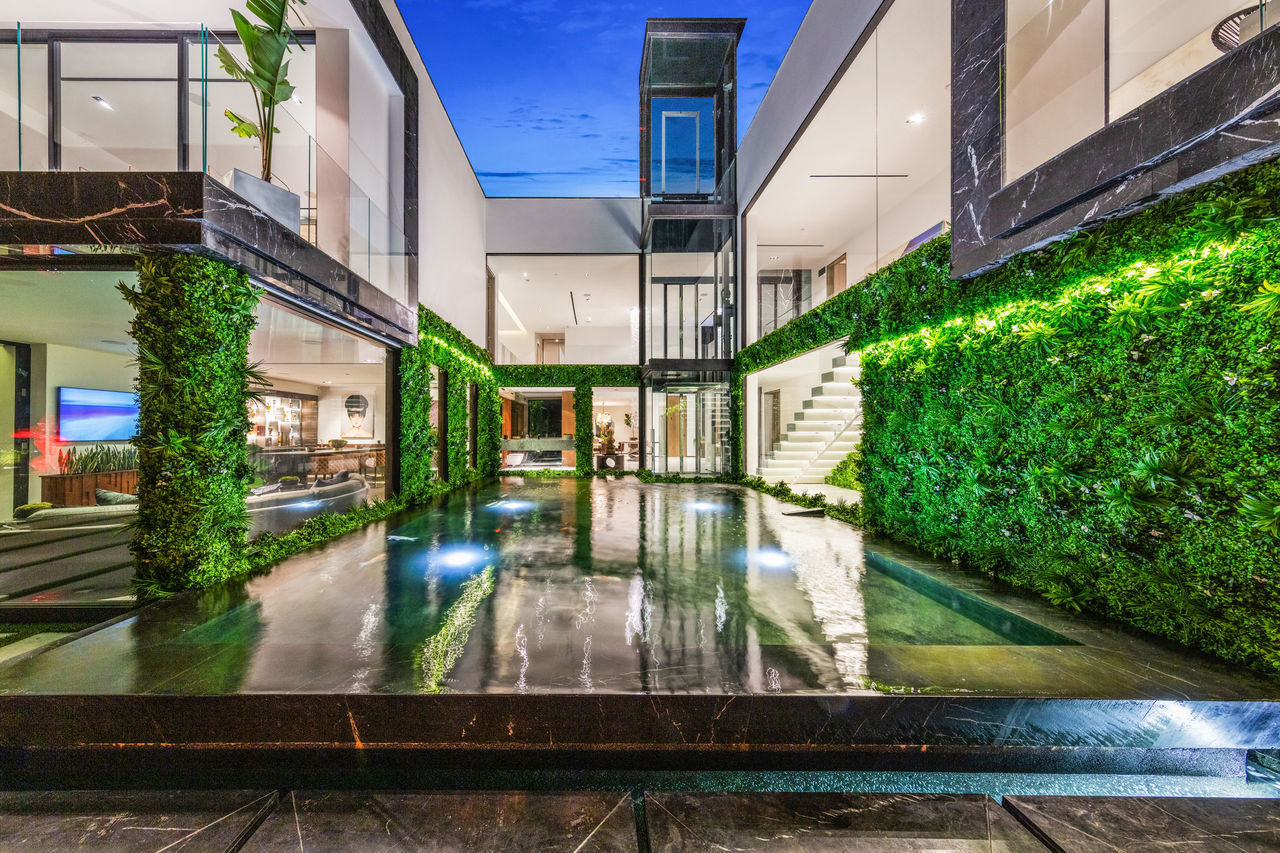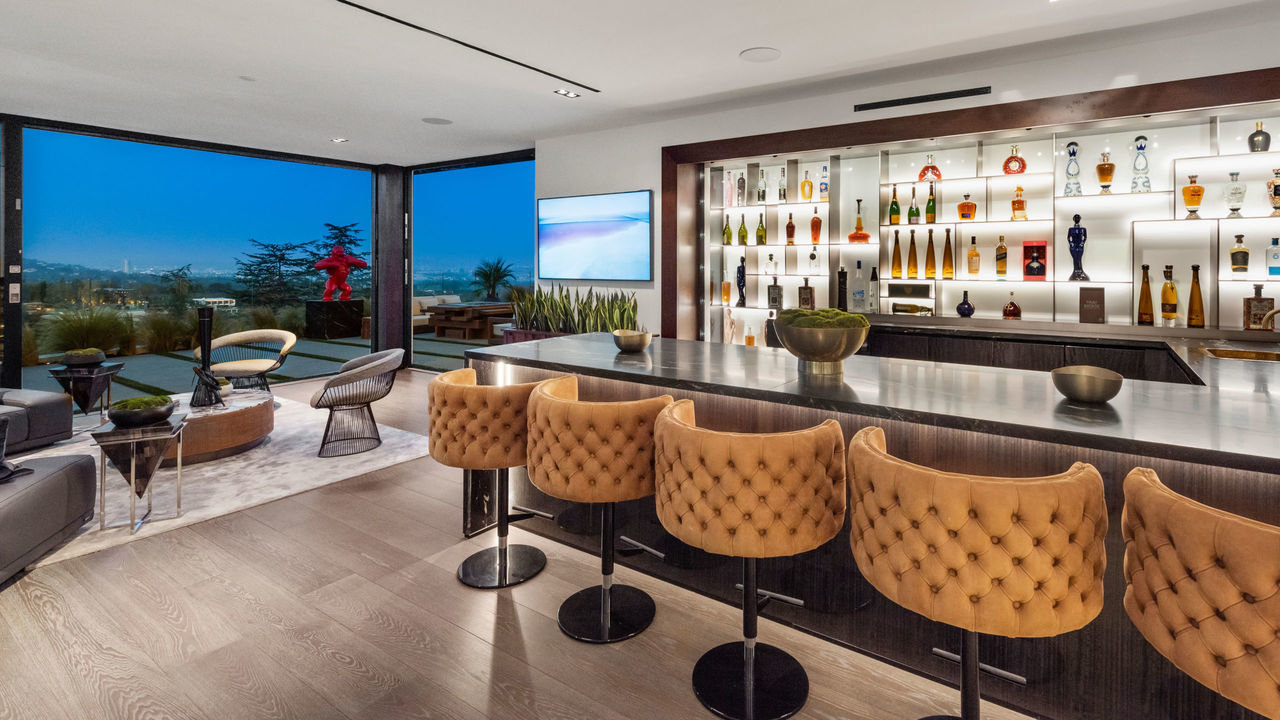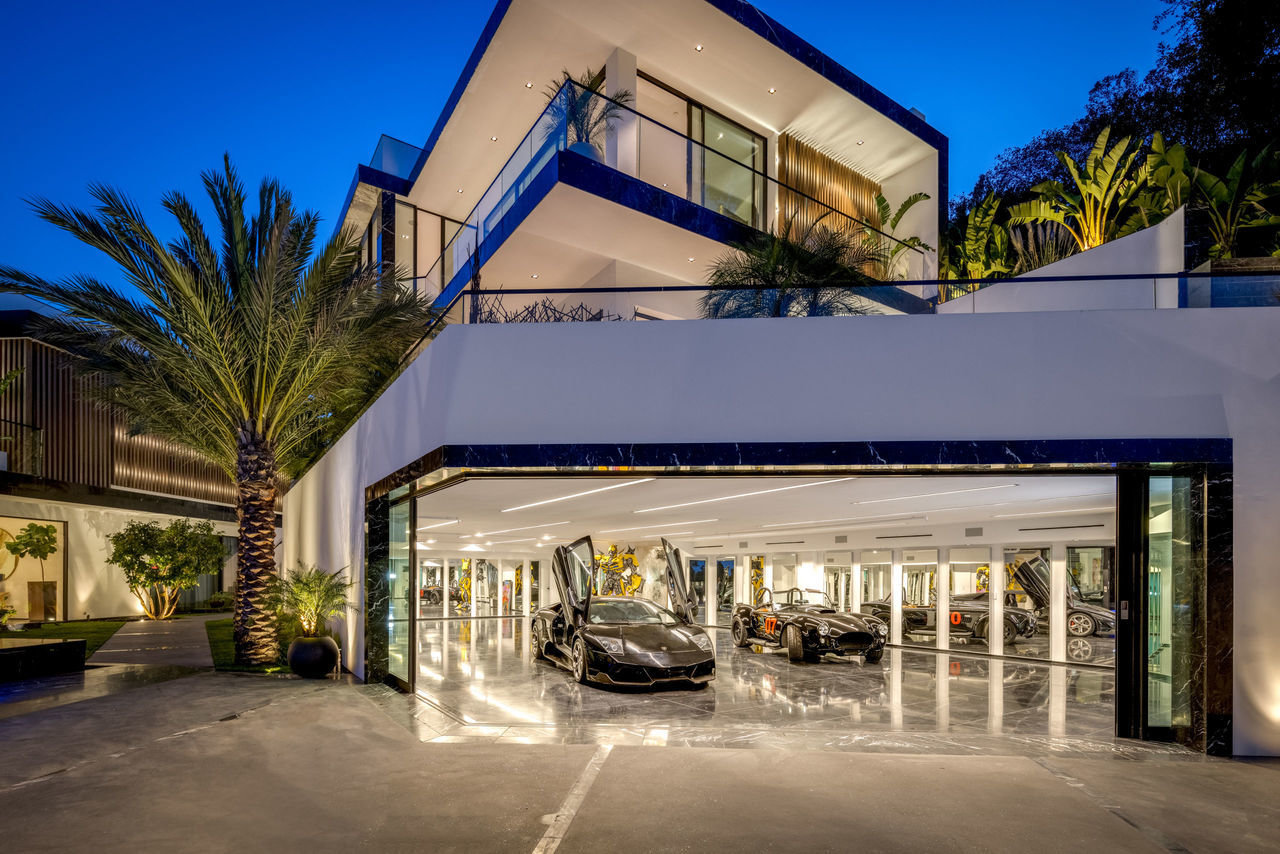Cosmetic Surgeons Are Building L.A. Megamansions
And the results are over the top.
And the results are over the top.
It could only happen in Los Angeles: Celebrity plastic surgeons are getting into the megamansion-building business.
The latest entrant to the market is Alex Khadavi, a 48-year-old dermatologist known for everything from Botox to buttock-enhancement procedures as well as for a clientele that has included singer Lance Bass and actor David Hasselhoff. Dr. Khadavi is listing his recently completed Bel-Air megamansion for $87.777 million, making it one of the highest-priced properties to have gone on the market in recent months.
Dr. Khadavi joins the likes of Raj Kanodia, doctor to the Kardashian clan and so-called “King of L.A. Rhinoplasties,” and Paul Nassif, a facial-plastic surgeon known for his role in the reality-television series “Botched,” in diverting their attention to the high-end development game. Dr. Kanodia first listed his Bel-Air megamansion for $180 million in 2018, while Dr. Nassif is listing a nearly completed mansion in the same area for US$32 million.

Dr. Khadavi—whose jet-black eyebrows, chiselled features and perfectly coiffed hair allows him to seamlessly blend in with his clients on his Instagram account—says he got carried away with the project. He says he paid US$16 million for the existing property in 2013 and had planned to spend roughly $10 million more on a new glassy contemporary home. Instead, he devoted seven years and roughly $US30 million to the more-than-1950-square-metre compound.
“It’s like when you go to a car dealership to buy a Toyota and they show you a Ferrari or a Lamborghini,” he says of choosing the materials and finishes. “It’s like, ‘Hey, I want that one!’ You can’t pass it up.”
The result is over-the-top, even for Los Angeles. Known as “Palazzo di Vista,” the modern seven-bedroom contemporary sits behind enormous mirrored-steel gates on an elevated parcel of land with 360-degree views spanning from the San Gabriel Mountains to the Channel Islands.
In the middle of the grand foyer, a push of a button reveals a surprise: The floor opens up to reveal a DJ platform on a hydraulic lift. Push another button, and smoke machines send fog throughout “the cube”—the surrounding glassed-in living room area that also has a glass-bottomed bridge overlooking the space.
In the pool outside, several powerful jets are set to automatically begin pumping the water in time with music, so guests in the water can feel the bass. The pool also is the setting for a digital show that Dr. Khadavi likens to Disneyland’s elaborate “World of Color” attraction. A rotatable 3-D laser projector on the roof casts light in a rhombic-shape up to 153sqm over the pool.
The purpose of the light show isn’t to project princesses; it is designed to display the latest art-world craze: NFT artwork. An NFT, which stands for “nonfungible tokens,” is a digital asset that serves as a kind of deed to prove ownership of various digital artifacts, like works of art.
In addition to the NFT pool display, the home also includes a “multisensory” NFT art gallery comprising seven indoor large-screen media displays dotted throughout the house. Valued at $7 million, the art collection is also available for sale and includes pieces by Ghost Girl—a 3-D artist who offers visual experiences for “VJing,” a kind of real-time visual performance—and Bighead, a record producer and DJ who worked on the production of the 2017 hit “Gucci Gang” by hip-hop artist Lil Pump.
The home also includes a glass elevator that is positioned to look as though it is plunging into a koi pond as it heads to the basement. There is also a formal dining room, a Champagne-tasting room, a movie theatre, a massage room, a car museum and a detached guesthouse with an outdoor tequila bar, according to listing agents Aaron Kirman of Compass and Mauricio Umansky of the Agency. Dr. Khadavi planted 56 Moroccan date palm trees around the perimeter of the property for privacy.
Dr. Khadavi, who oversees two dermatology practices in Los Angeles, says his pursuit of perfection became all-consuming. Within the first year, he had fired his architect. Soon after, he replaced his contractor and got rid of his interior designer. “I’ve pretty much been doing it myself,” he says. “I tell people I got a degree in interior design from Pinterest.”

There were other sources of inspiration. The doctor says the proportions of the house were inspired by the “golden ratio” of Italian mathematician Fibonacci. The sevens in the asking price are a nod to Dr. Khadavi’s favourite number; he and his family moved to the U.S. from Iran when he was 7 to escape the revolution.
No expense was spared. “Instead of going for the $10-a-square-foot marble, I went for the $150 to $200 a square foot marble,” Dr. Khadavi says. “This property deserves the best.”
When it came to refining the aesthetics of the house, the dermatologist says he drew on his work. “When I do injectables in people’s faces… I always look and see what I could do above and beyond to make this person better, “ he says. “Every person is beautiful, you have to make them more beautiful.”

Plastic surgeons like Dr. Khadavi are among a larger group of high-net-worth individuals who piled into Los Angeles’s luxury housing development space over the past few years. With the market heating up in the early 2010s, many wealthy people with well-positioned parcels of land began building properties geared toward foreign buyers and billionaires, says Stephen Shapiro of Westside Estate Agency, who is not involved in the home. Suddenly, everyone was a developer, including those with limited or no real-estate experience. That boom resulted in an oversupply of spec homes.

For some of these surgeons, building a distinctive architectural home is a way to express themselves in a new way. “One of the reasons I built [my house] was to express my artistic vision through another medium, in addition to the scarless rhinoplasty and facial enhancement,” Dr. Kanodia says.
For his part, Dr. Nassif says he found that the patience and attention to detail he honed in his surgery work proved useful in real estate. “You have to look at everything with very scrutinous glasses in surgery,” he says. “I’m doing the same thing with the house.”
In real estate, like in surgery, it’s wise to expect the unexpected, Dr. Nassif says. “You’re dealing with problems all the time,” he says. “An issue comes up with a contractor or you can’t get marble into the Port of California because of Covid delays. It’s never as easy as you think it would be.”
The rush of new contemporary spec homes built in the Los Angeles area has put downward pressure on prices. While Dr. Nassif says he’s had significant interest in his home since listing it earlier this year, Dr. Kanodia recently slashed the asking price of his home to US$99 million from US$180 million. Developers like Nile Niami, known widely as the king of Los Angeles spec homes, handed the keys over to his lenders on at least one project and is facing default on others, The Wall Street Journal has reported.
The spiralling costs of Dr. Khadavi’s project also had consequences. While he initially thought he might live in the property, Dr. Khadavi says he is now selling it largely because he can’t afford to keep it. It’s also too large for him, his girlfriend and his Goldendoodle Cheetos. “I don’t have a large family, and I don’t have the financial capability to enjoy the house,” he says. “I borrowed a lot of money to get it to this level, and I can’t afford living in it.”
Anyone living in the mansion would “need to probably have a couple of butlers and a couple of maids,” he says.
Mr. Umansky says the house is an entertainer’s paradise, and he is confident he will find a buyer looking for that party lifestyle.
“In order to be great you have to dare to be bad. You have to take risks,” Mr. Umansky says, noting that cookie-cutter houses don’t stand out in a crowded market. “There are these tech and cryptocurrency guys who are still young and who want to have fun.”
Reprinted by permission of The Wall Street Journal, Copyright 2021 Dow Jones & Company. Inc. All Rights Reserved Worldwide. Original date of publication: May 8, 2021.
 Copyright 2020, Dow Jones & Company, Inc. All Rights Reserved Worldwide. LEARN MORE
Copyright 2020, Dow Jones & Company, Inc. All Rights Reserved Worldwide. LEARN MORE
What a quarter-million dollars gets you in the western capital.
Alexandre de Betak and his wife are focusing on their most personal project yet.
Ahead of the Games, a breakdown of the city’s most desirable places to live
PARIS —Paris has long been a byword for luxurious living. The traditional components of the upscale home, from parquet floors to elaborate mouldings, have their origins here. Yet settling down in just the right address in this low-rise, high-density city may be the greatest luxury of all.
Tradition reigns supreme in Paris real estate, where certain conditions seem set in stone—the western half of the city, on either side of the Seine, has long been more expensive than the east. But in the fashion world’s capital, parts of the housing market are also subject to shifting fads. In the trendy, hilly northeast, a roving cool factor can send prices in this year’s hip neighbourhood rising, while last year’s might seem like a sudden bargain.
This week, with the opening of the Olympic Games and the eyes of the world turned toward Paris, The Wall Street Journal looks at the most expensive and desirable areas in the City of Light.
Known for historic architecture, elegant apartment houses and bohemian street cred, the 6th Arrondissement is Paris’s answer to Manhattan’s West Village. Like its New York counterpart, the 6th’s starving-artist days are long behind it. But the charm that first wooed notable residents like Gertrude Stein and Jean-Paul Sartre is still largely intact, attracting high-minded tourists and deep-pocketed homeowners who can afford its once-edgy, now serene atmosphere.
Le Breton George V Notaires, a Paris notary with an international clientele, says the 6th consistently holds the title of most expensive arrondissement among Paris’s 20 administrative districts, and 2023 was no exception. Last year, average home prices reached $1,428 a square foot—almost 30% higher than the Paris average of $1,100 a square foot.
According to Meilleurs Agents, the Paris real estate appraisal company, the 6th is also home to three of the city’s five most expensive streets. Rue de Furstemberg, a secluded loop between Boulevard Saint-Germain and the Seine, comes in on top, with average prices of $2,454 a square foot as of March 2024.
For more than two decades, Kyle Branum, a 51-year-old attorney, and Kimberly Branum, a 60-year-old retired CEO, have been regular visitors to Paris, opting for apartment rentals and ultimately an ownership interest in an apartment in the city’s 7th Arrondissement, a sedate Left Bank district known for its discreet atmosphere and plutocratic residents.
“The 7th was the only place we stayed,” says Kimberly, “but we spent most of our time in the 6th.”
In 2022, inspired by the strength of the dollar, the Branums decided to fulfil a longstanding dream of buying in Paris. Working with Paris Property Group, they opted for a 1,465-square-foot, three-bedroom in a building dating to the 17th century on a side street in the 6th Arrondissement. They paid $2.7 million for the unit and then spent just over $1 million on the renovation, working with Franco-American visual artist Monte Laster, who also does interiors.
The couple, who live in Santa Barbara, Calif., plan to spend about three months a year in Paris, hosting children and grandchildren, and cooking after forays to local food markets. Their new kitchen, which includes a French stove from luxury appliance brand Lacanche, is Kimberly’s favourite room, she says.
Another American, investor Ashley Maddox, 49, is also considering relocating.
In 2012, the longtime Paris resident bought a dingy, overstuffed 1,765-square-foot apartment in the 6th and started from scratch. She paid $2.5 million and undertook a gut renovation and building improvements for about $800,000. A centrepiece of the home now is the one-time salon, which was turned into an open-plan kitchen and dining area where Maddox and her three children tend to hang out, American-style. Just outside her door are some of the city’s best-known bakeries and cheesemongers, and she is a short walk from the Jardin du Luxembourg, the Left Bank’s premier green space.
“A lot of the majesty of the city is accessible from here,” she says. “It’s so central, it’s bananas.” Now that two of her children are going away to school, she has listed the four-bedroom apartment with Varenne for $5 million.
Garrow Kedigian is moving up in the world of Parisian real estate by heading south of the Seine.
During the pandemic, the Canada-born, New York-based interior designer reassessed his life, he says, and decided “I’m not going to wait any longer to have a pied-à-terre in Paris.”
He originally selected a 1,130-square-foot one-bedroom in the trendy 9th Arrondissement, an up-and-coming Right Bank district just below Montmartre. But he soon realised it was too small for his extended stays, not to mention hosting guests from out of town.
After paying about $1.6 million in 2022 and then investing about $55,000 in new decor, he put the unit up for sale in early 2024 and went house-shopping a second time. He ended up in the Invalides quarter of the 7th Arrondissement in the shadow of one Paris’s signature monuments, the golden-domed Hôtel des Invalides, which dates to the 17th century and is fronted by a grand esplanade.
His new neighbourhood vies for Paris’s most expensive with the Notre-Dame quarter in the 4th Arrondissement, centred on a few islands in the Seine behind its namesake cathedral. According to Le Breton, home prices in the Notre-Dame neighbourhood were $1,818 a square foot in 2023, followed by $1,568 a square foot in Invalides.
After breaking even on his Right Bank one-bedroom, Kedigian paid $2.4 million for his new 1,450-square-foot two-bedroom in a late 19th-century building. It has southern exposures, rounded living-room windows and “gorgeous floors,” he says. Kedigian, who bought the new flat through Junot Fine Properties/Knight Frank, plans to spend up to $435,000 on a renovation that will involve restoring the original 12-foot ceiling height in many of the rooms, as well as rescuing the ceilings’ elaborate stucco detailing. He expects to finish in 2025.
Over in the Notre-Dame neighbourhood, Belles demeures de France/Christie’s recently sold a 2,370-square-foot, four-bedroom home for close to the asking price of about $8.6 million, or about $3,630 a square foot. Listing agent Marie-Hélène Lundgreen says this places the unit near the very top of Paris luxury real estate, where prime homes typically sell between $2,530 and $4,040 a square foot.
The Boulevard Périphérique, the 22-mile ring road that surrounds Paris and its 20 arrondissements, was once a line in the sand for Parisians, who regarded the French capital’s numerous suburbs as something to drive through on their way to and from vacation. The past few decades have seen waves of gentrification beyond the city’s borders, upgrading humble or industrial districts to the north and east into prime residential areas. And it has turned Neuilly-sur-Seine, just northwest of the city, into a luxury compound of first resort.
In 2023, Neuilly’s average home price of $1,092 a square foot made the leafy, stately community Paris’s most expensive suburb.
Longtime residents, Alain and Michèle Bigio, decided this year is the right time to list their 7,730-square-foot, four-bedroom townhouse on a gated Neuilly street.
The couple, now in their mid 70s, completed the home in 1990, two years after they purchased a small parcel of garden from the owners next door for an undisclosed amount. Having relocated from a white-marble château outside Paris, the couple echoed their previous home by using white- and cream-coloured stone in the new four-story build. The Bigios, who will relocate just back over the border in the 16th Arrondissement, have listed the property with Emile Garcin Propriétés for $14.7 million.
The couple raised two adult children here and undertook upgrades in their empty-nester years—most recently, an indoor pool in the basement and a new elevator.
The cool, pale interiors give way to dark and sardonic images in the former staff’s quarters in the basement where Alain works on his hobby—surreal and satirical paintings, whose risqué content means that his wife prefers they stay downstairs. “I’m not a painter,” he says. “But I paint.”
French interior designer Julie Hamon is theatre royalty. Her grandfather was playwright Jean Anouilh, a giant of 20th-century French literature, and her sister is actress Gwendoline Hamon. The 52-year-old, who divides her time between Paris and the U.K., still remembers when the city’s 9th Arrondissement, where she and her husband bought their 1,885-square-foot duplex in 2017, was a place to have fun rather than put down roots. Now, the 9th is the place to do both.
The 9th, a largely 19th-century district, is Paris at its most urban. But what it lacks in parks and other green spaces, it makes up with nightlife and a bustling street life. Among Paris’s gentrifying districts, which have been transformed since 2000 from near-slums to the brink of luxury, the 9th has emerged as the clear winner. According to Le Breton, average 2023 home prices here were $1,062 a square foot, while its nearest competitors for the cool crown, the 10th and the 11th, have yet to break $1,011 a square foot.
A co-principal in the Bobo Design Studio, Hamon—whose gut renovation includes a dramatic skylight, a home cinema and air conditioning—still seems surprised at how far her arrondissement has come. “The 9th used to be well known for all the theatres, nightclubs and strip clubs,” she says. “But it was never a place where you wanted to live—now it’s the place to be.”
With their youngest child about to go to college, she and her husband, 52-year-old entrepreneur Guillaume Clignet, decided to list their Paris home for $3.45 million and live in London full-time. Propriétés Parisiennes/Sotheby’s is handling the listing, which has just gone into contract after about six months on the market.
The 9th’s music venues were a draw for 44-year-old American musician and piano dealer, Ronen Segev, who divides his time between Miami and a 1,725-square-foot, two-bedroom in the lower reaches of the arrondissement. Aided by Paris Property Group, Segev purchased the apartment at auction during the pandemic, sight unseen, for $1.69 million. He spent $270,000 on a renovation, knocking down a wall to make a larger salon suitable for home concerts.
During the Olympics, Segev is renting out the space for about $22,850 a week to attendees of the Games. Otherwise, he prefers longer-term sublets to visiting musicians for $32,700 a month.
Hidden in the hilly expanses of the 18th Arrondissement lies a legendary street that, for those in the know, is the city’s most exclusive address. Avenue Junot, a bucolic tree-lined lane, is a fairy-tale version of the city, separate from the gritty bustle that surrounds it.
Homes here rarely come up for sale, and, when they do, they tend to be off-market, or sold before they can be listed. Martine Kuperfis—whose Paris-based Junot Group real-estate company is named for the street—says the most expensive units here are penthouses with views over the whole of the city.
In 2021, her agency sold a 3,230-square-foot triplex apartment, with a 1,400-square-foot terrace, for $8.5 million. At about $2,630 a square foot, that is three times the current average price in the whole of the 18th.
Among its current Junot listings is a 1930s 1,220-square-foot townhouse on the avenue’s cobblestone extension, with an asking price of $2.8 million.